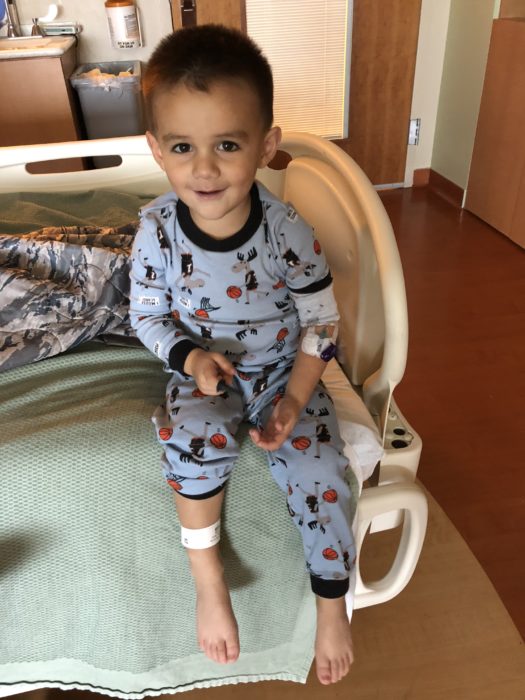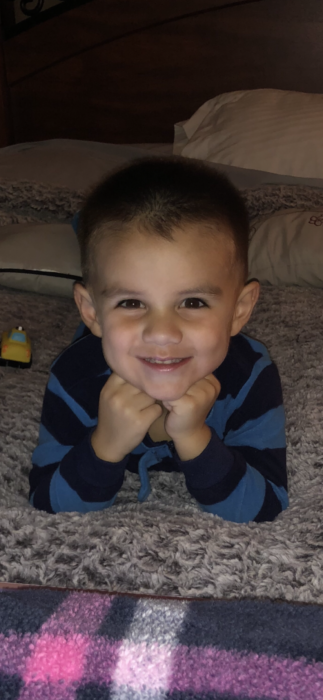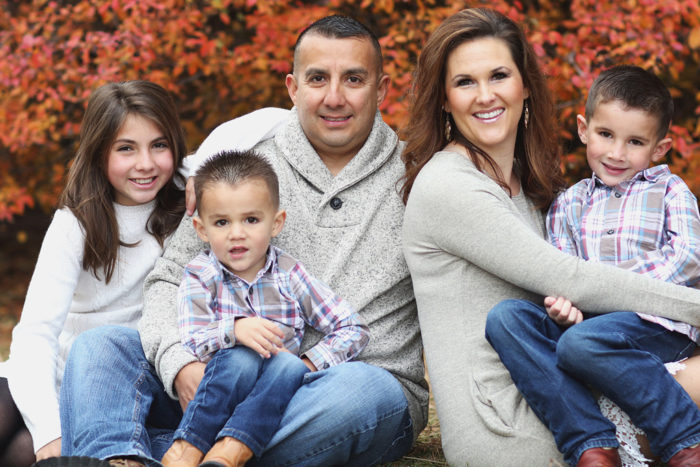Two-Year-Old Battles Life-Threatening Disease
November 26, 2018
CRMC to Host Blood and Bone Marrow Registry Drives on November 30, 2018, 9 a.m. to Noon
In early October Cheyenne resident Shelby Martinez noticed that her two-year-old son, Easton, had a lot of bruises.

“His shins were covered with them, and it wasn’t due to falls or anything he’d run into,” she said.
As a precaution, Shelby took Easton to the Cheyenne Children’s Clinic, where he is cared for by pediatricians Dr. Robert Leland and Dr. Joanne Hassell.
A long-time nurse at Cheyenne Regional Medical Center, Shelby said she wasn’t too worried at first. Other than the bruises, Easton was acting like a normal two-year-old.
“He still ran around and played. He might have been a bit more tired than normal,” she said, “but nothing really out of the ordinary.”
When the doctors saw the results of the Easton’s blood tests, they told Shelby and her husband, Mario, they needed to take their little boy to Children’s Hospital in Denver right away.
Easton’s blood cell count was extremely low. “If he was exposed to any kind of sickness, it could kill him,” Shelby said.
Easton’s Diagnosis
Easton was at Children’s Hospital for six days while he underwent tests. He also received a blood and platelets transfusion before being allowed to go home.
“Initially the doctors at Children’s thought he might have leukemia,” Shelby said. Leukemia is a type of cancer with symptoms similar to Easton’s. That diagnosis shook Shelby and Mario to their core.
“We weren’t prepared for our two-year-old to have cancer,” Shelby said.
After a bone marrow biopsy ruled out leukemia, Easton was diagnosed with having severe aplastic anemia. “It impacts the bone marrow’s ability to produce blood cells and platelets,” Shelby said.
The next step was to see if Easton’s bone marrow might start working on its own.
Two weeks later Easton underwent a second bone marrow biopsy at Children’s Hospital. That test showed that Easton’s bone marrow had started producing red and white blood cells and platelets again.
“When we heard the results, it was like having a thousand-pound weight lifted from our shoulders,” Shelby said.
While the news is good, Easton isn’t out of the woods, yet.
Easton’s doctors don’t know what caused the little boy’s marrow to quit working.
“They’re just not sure. It could have been a virus that attacked his body. Or it could be something else,” Shelby said. “At this point, we don’t know what his future holds.”
As of early November, Easton’s blood cell count was about half what it needed to be.
“His numbers are better but not where they should be for him to be considered ‘well,’ ” Shelby said. “He can’t go to daycare or be around anyone who is sick. If he got sick, that could take his blood cell count back down to zero, and that could put his life at risk again.”
Fortunately, extended family are helping care for Easton so that Shelby and Mario can continue to work.
“This past month has been like a roller coaster. We’ve really needed everyone’s support and are so grateful for how much help and understanding we’ve been given from our co-workers, family and friends,” Shelby said.
Finding a Bone Marrow Match
 Easton will continue to have blood tests to make sure his bone marrow is producing healthy blood cells and platelets.
Easton will continue to have blood tests to make sure his bone marrow is producing healthy blood cells and platelets.
If at some point his bone marrow quits working again, Easton would likely need a bone marrow transplant.
Shelby and Mario remain optimistic but also understand that the odds may be against their little boy.
“We were told that only about one in 10 children with Easton’s condition bounce back on their own,” she said.
Over the past few weeks the Martinez family has been tested to see if any of them could donate bone marrow to Easton.
“They determine donor candidates by seeing how well their bone marrow genetic markers match those of the recipient’s,” Shelby said.
Nationwide, less than a third of patients who need a marrow transplant will find a match within their families.
Fortunately, Easton’s 11-year-old sister, Bailey, was found to be one of the best donor candidates possible for Easton. “They call this kind of sibling match the golden standard,” Shelby said.
The other good news is that donating marrow is considered to be extremely safe. Doctors extract bone marrow from the donor’s hip. Someone Bailey’s age would also be sedated. The donor can normally go home the next day.
For now, though, the family hopes that Easton’s bone marrow does what it’s supposed to.
“We would rather not have to put Bailey through this, even though see’s volunteered and has talked to the transplant team about what it would be like,” Shelby said.
 How You Can Help
How You Can Help
Most Americans who need a bone marrow transplant must turn to the national bone marrow registry to search for a donor. About 3,000 Americans die every year because they cannot find a match.
To help, Shelby and her family are asking community members to sign up for the national bone marrow registry, called Be The Match, at an upcoming blood drive being held in the main auditoriums at Cheyenne Regional Medical Center on Friday, November 30, from 9 a.m. to noon.
Volunteers will be available to explain what it means to join the registry, help people create an online account and order a cheek swab kit. If you have a smartphone, you are asked to bring it with you to help with the registration process. The greatest need is for bone marrow donors between the ages of 18 and 44 years. (Research shows that younger donors are best for patients since they provide the greatest chance for transplant success.)
“This is the scariest thing that has ever happened to me and our family,” Shelby said of Easton’s diagnosis and the chance that he may someday need a transplant. “I can’t imagine what it would be like if we didn’t already have a donor match that could save his life.”